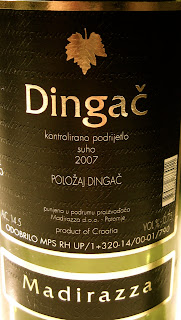Ever since moving to Budapest, we've been cooking our beans from scratch (except, admittedly, when needing to make a bean salad as part of a 20-person barbecue...). It's easy, it's versatile and it adds a tremendous amount of flavor to the beans. Garlic, all manner of spices, bay leaves, bacon, and some vegetables can be used -- anything, essentially, which is not acidic. Tomatoes and the like will prevent the beans from softening.
Chickpeas are one of the simplest beans to cook, since it's nearly impossible to overcook them. This chickpea salad has quickly become a favorite of ours for dinners, packed lunches and even airplanes snacks. Cooked with bay leaves, tossed in an olive oil-balsamic-Dijon dressing, and mixed with some red onion and garlic, it can be made as sharp or as mild as you like. The salad can also be combined with a variety of vegetables -- cucumber, red pepper and tomato being my favorites.
The most common complaint I hear about cooking beans from scratch is that it takes a very long time. It doesn't. It takes, at most, a couple of hours. You do not need to soak beans overnight. You do not need to spend all whole day coaxing them along. You just need one to three hours (depending on the type of bean), during which time you only need to be in the kitchen for a total of 15 minutes. And -- it will bring the most beautiful smell into your kitchen. It's worth it.
Chickpea salad
What you need (4-ish servings):
- 1 heaping cup dry chickpeas, picked over and rinsed
- 2 bay leaves
- 1-2 cloves garlic, minced
- 1/2 red onion, minced
- olive oil
- balsamic vinegar (be sure to use good quality balsamic)
- Dijon mustard
- 1 cucumber and/or 1 red bell pepper and/or 2 tomatoes
What you do:
- Place the chick peas in a large pot, and cover with 2-3 inches of water. Add the bay leaves. Bring to a boil over medium-high heat, then reduce heat to low and simmer for 1-1.5 hours, stirring occasionally. Add more hot water if the water level falls below the chickpea level (don't forget -- if there isn't enough water in the pot, the chickpeas won't soften). The chickpeas are finished when they are soft, but still have bite. I recommend checking them after one hour, and every 10 minutes afterwards until they are done. Depending on the humidity and temperature in my kitchen, mine usually take between 1 hour and 1 hour 20 minutes. Drain, remove bay leaves and set the chickpeas aside in a large bowl. Allow to cool to room temperature (or slightly warmer).
- Use the olive oil, balsamic vinegar and Dijon mustard to make a dressing. I don't like too much dressing, so I typically use 2 tbsp olive oil, a couple of drops of balsamic and a heaping 1/2 tsp mustard.
- Mix the minced garlic and red onion with the chickpeas, and then stir in the dressing.
- Before serving, mix with cucumber/red pepper/tomato. The salad can be served on its own or over lettuce.










